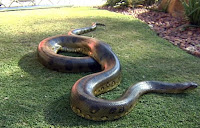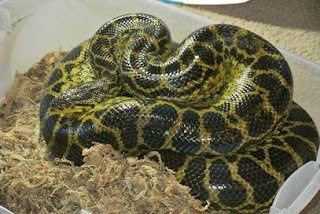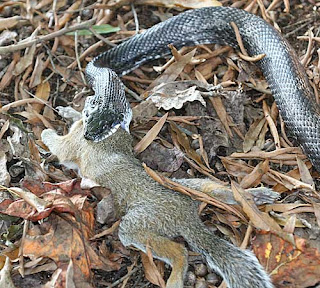ANACONDA DESCRIPTION
 |
| Big Anaconda. |
There is some debate about the maximum size of
Anacondas and there have been unverified claims of enormous snakes alleged to
be as long as 30 – 45 metres (98.4 – 147.6 feet). Some Anacondas, which live in
the water, can reach up to 30 feet in length.
GREEN ANACONDA SNAKE
The Green Anaconda (Eunectes murinus) is the largest
member of the boa family of snakes and the most heavy bodied member of the
super-order ‘Squamata’. The Green Anaconda is among the largest snakes in the
world. It rivals the Reticulated Python in length, but is typically
considerably heavier. It can weigh 250 kilograms (551 pounds) and have a girth of
more than 30 centimetres (11.8 inches) in diameter.
 |
| Green Anaconda. |
Female anacondas are significantly larger than
males, having the largest sexual dimorphism of all the snakes.
The primary colour of the Green Anaconda is an olive
green, with black blotches that run the length of the body. Their head is
narrow compared to the rest of the body, with most exhibiting distinctive
orange-yellow striping on either side. Their eyes are set high on their head so
as to allow the snake to be able to see out of the water without exposing the
rest of its body.
YELLOW ANACONDA SNAKE
 |
| Yellow Anaconda. |
The Yellow Anaconda (Eunectes notaeus), is native to
South America in countries such as Bolivia, Paraguay, Uruguay, western Brazil
and northeast Argentina. The Yellow Anaconda is smaller than the more well
known Green Anaconda and reaches an average adult length of about 3 metres (9.8
feet).
Yellow Anacondas have a yellow/brown base colour
with black blotches and rosettes. Yellow Anacondas live in mostly aquatic
habitats including swamps, marshes and brush covered banks of slow moving
rivers and streams.
Just about every species of snake on earth has
teeth, but the Anacondas teeth are not used for chewing. Most snakes teeth are
used for holding onto their prey, preventing them from escaping. Some snakes
have venom in two specially designed, extra long teeth which they use to kill
their prey.
Anacondas have teeth, however, they are not a
venomous snake. They rely on their enormous size and power to subdue their
victims. It is possible to be bitten by an Anaconda, but the bite itself would
not be fatal.
ANACONDA DIET
 |
| Anaconda hunting |
The Anaconda diet includes deer, wild pigs, birds
and large rodents and also aquatic animals such as fish and reptiles (caiman).
Anacondas swim well and kill their prey by strangling them. If that does not
work, they drown them. These snakes can survive years without eating.
Anacondas also typically feed on tapirs, capybaras,
peccaries, turtles, sheep and dogs. They have been known to occasionally prey
on jaguars and attacks on humans can be confirmed, although this is rare.
Anacondas swallow their prey whole, starting with the
head. This is so the legs fold up and the prey goes down smoothly. The Anaconda
can swallow prey much bigger than the size of its mouth since its jaw can
unhinge and the jaw bones are loosely connected to the skull. While the snake
eats, its muscles have wave-like contractions, crushing the prey even further
and surging it downward with each bite.
ANACONDA BEHAVIOUR
 |
| Anaconda snake |
The Anaconda is most active at night which makes it
a nocturnal reptile. Although they are not venomous, they defend themselves by
inflicting severe bites, but actually kill its prey by constriction.
Most local people kill these snakes on sight, out of
the fear that they are man-eaters. In most instances, if an Anaconda senses
humans in the area, it will retreat in another direction. Human death by an
Anaconda is quite rare. Anacondas themselves are preyed by jaguars, large
caimans and by other Anacondas. A wounded Anaconda can also fall prey to
piranhas.
ANACONDA REPRODUCTION
 |
| Younger Anacondas |
The Anaconda is an
amphibious snake. It gives birth to live young.During mating, several males will coil around the female in the water,
sometimes for several weeks. Females keep their eggs inside them and give birth
to 20-40 live young, which are immediately able to swim and hunt.Younger
Anacondas feed on mice, rats, chicks, frogs and fish. After
eating a large animal, the anaconda needs no food for a long time, and rests for weeks

 Habits: Adult rat snakes primarily eat mice, rats, squirrels, and
birds, as well as bird eggs. They are a common predator on wood duck eggs.
Juveniles eat small frogs, lizards, and small rodents. Rat snakes are
constrictors, and adept climbers that can scale brick walls as well as tree
trunks. When frightened they often assume a “kinked” posture and remain
motionless. They will vibrate the tail and expel malodorous musk.
Habits: Adult rat snakes primarily eat mice, rats, squirrels, and
birds, as well as bird eggs. They are a common predator on wood duck eggs.
Juveniles eat small frogs, lizards, and small rodents. Rat snakes are
constrictors, and adept climbers that can scale brick walls as well as tree
trunks. When frightened they often assume a “kinked” posture and remain
motionless. They will vibrate the tail and expel malodorous musk.






